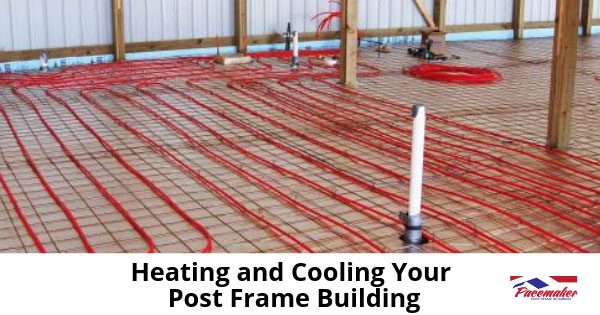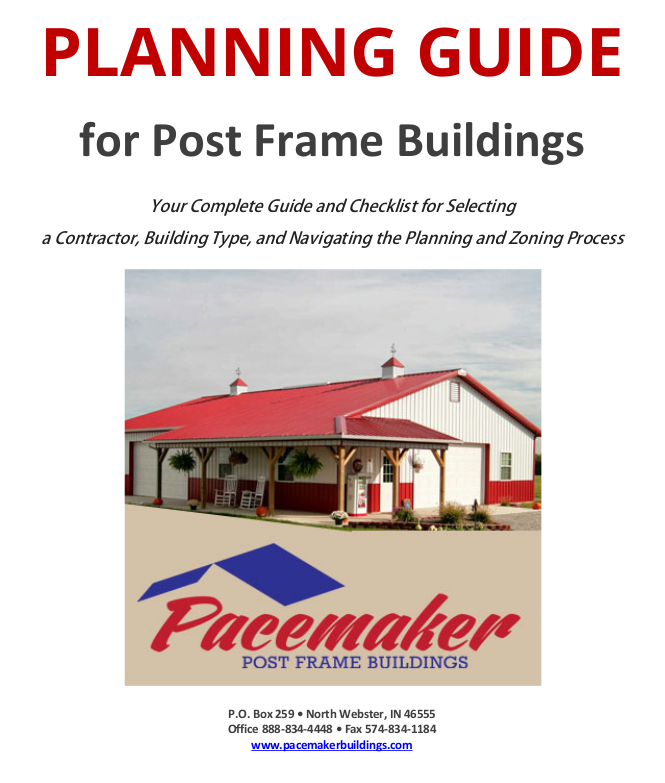 The efficient heating and cooling of your post frame building is essential for maintaining the comfort of occupants. As with any building method, planning the heating and cooling systems within your post frame building is a crucial step.
The efficient heating and cooling of your post frame building is essential for maintaining the comfort of occupants. As with any building method, planning the heating and cooling systems within your post frame building is a crucial step.
Energy Efficiency of Post Frame Structures
Heating and cooling energy costs make up a significant percentage of any building’s annual operating expenses. Especially in hot and frigid climates where temperatures may hover around 100°F or 0°F for extended periods.
A well-insulated structure allows for greater efficiency and reduced energy costs. Post frame buildings offer real advantages over standard wood frame structures due to:
- Frame Spacing: Because the vertical support post spacing for a post frame building is 6-10 feet, insulation can be installed more uniformly with a smaller number of gaps around the perimeter and in the roofing system.
- Fewer Energy-Conducting Frame Pieces: Standard wood or “stick frame” methods consist of framing members at 16-inch intervals. Each of these becomes energy conductors allowing energy to escape more easily. The 6-foot spacing of post-frame construction reduces energy transfer.
- Insulation Depth: Post frame vertical posts are made of thick, heavy wooden posts. As a result, the larger cavity depth between the outer wall covering and the inner space of finished wall allows for additional insulation.
Planning Efficient Low-Cost Heating and Cooling for Post Frame Buildings
When planning the heating and cooling your post frame building, first check with your local energy provider. These companies often offer rebates and credits when you install high-efficiency equipment.
All or Part?
One consideration when planning the climate control of your post frame building is whether you need to heat or cool the entire building or only a section. Naturally, there is no reason to heat an area that does not require it.
Heating Options
Heat Pumps are all-in-one, forced air cooling, and heating devices. Powered by electricity, an air-source heat pump will transfer heat energy from the outside to the interior during the cold weather. In the summer, the pump moves heat to the outside, creating a cooler interior. This method is particularly efficient when both heating and cooling are needed throughout the year.
Furnaces use various fuels to generate heat that can be distributed through a duct system. However, if only a smaller space needs heating, a ceiling-suspended forced air system may provide ample comfort.
Radiant Heat Systems are available in three basic categories:
- Radiant floor heating generated by heated water
- Surface-mounted ceiling panels
- Wood-burning stoves
Wood-burning stoves burn logs, pellets, corn, or other material. And may be located either inside to provide area warmth or outside to send heat through a duct system.
Cooling Options
As mentioned, a heat pump system is an efficient way to keep your post frame structure cool in warm weather. These work by pumping interior heat to the exterior, leaving a cool space inside.
If the entire structure needs cooling, a central air conditioning system that uses the ductwork for the forced air furnace can provide ample cooling for workers or inhabitants.
Alternatively, if only a section of the building needs cooling, such as a single office or workspace, a window air conditioning unit could do the job.
For structures housing livestock, fans and good ventilation are necessary. Placing vent fans at either end of the building will keep the air moving and the space comfortable. Interior misting and spraying systems also maintain comfortable temperatures while holding airborne dust down. With proper ventilation, these can be another option for cooling.
Contact Pacemaker Post Frame Buildings
Pacemaker designs and produces components and constructs high-quality and economical post frame buildings throughout the Great Lakes and upper Midwest regions.
For more information, visit the Pacemaker website or phone the Pacemaker professionals at 888-834-4448.
